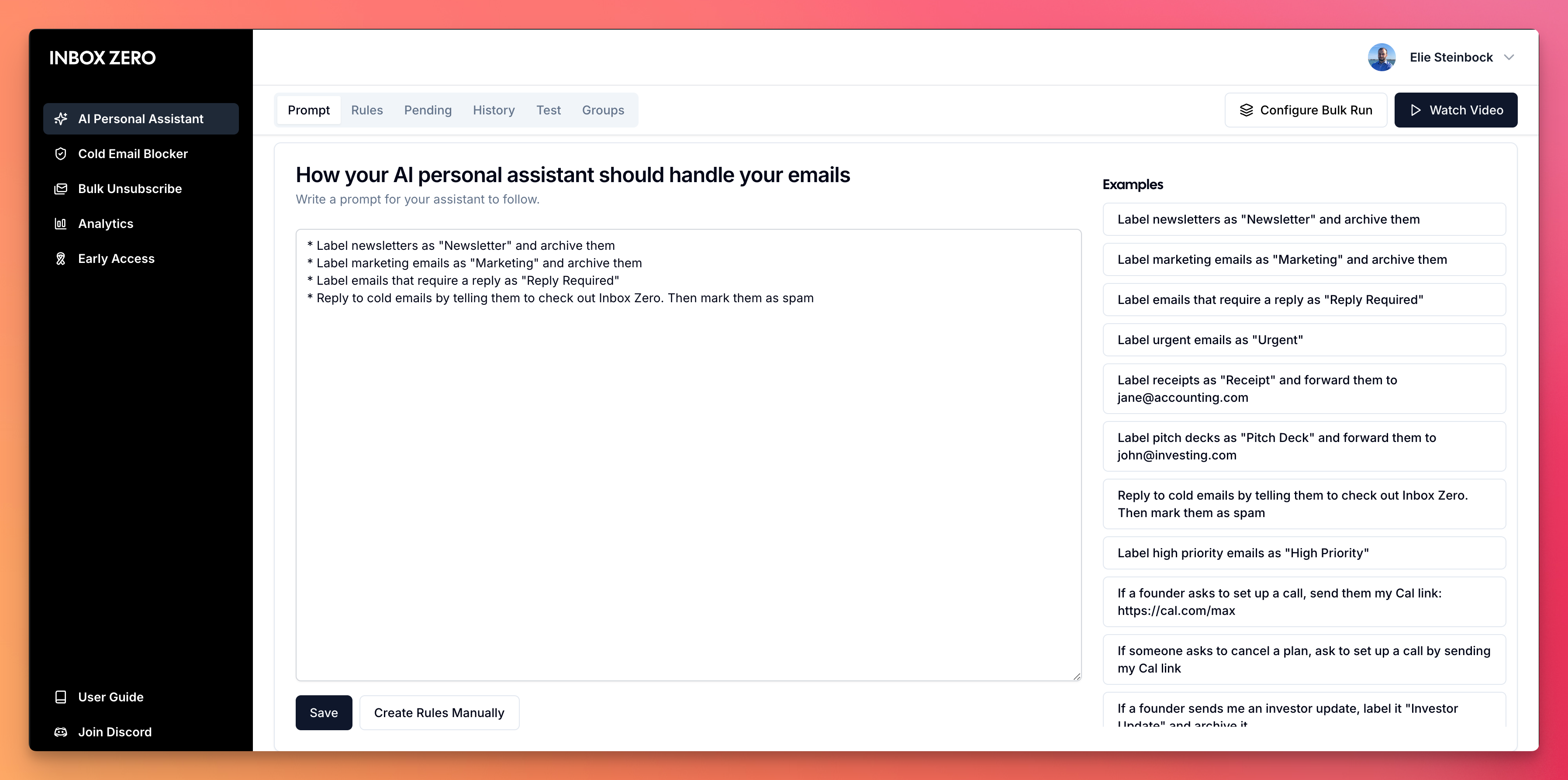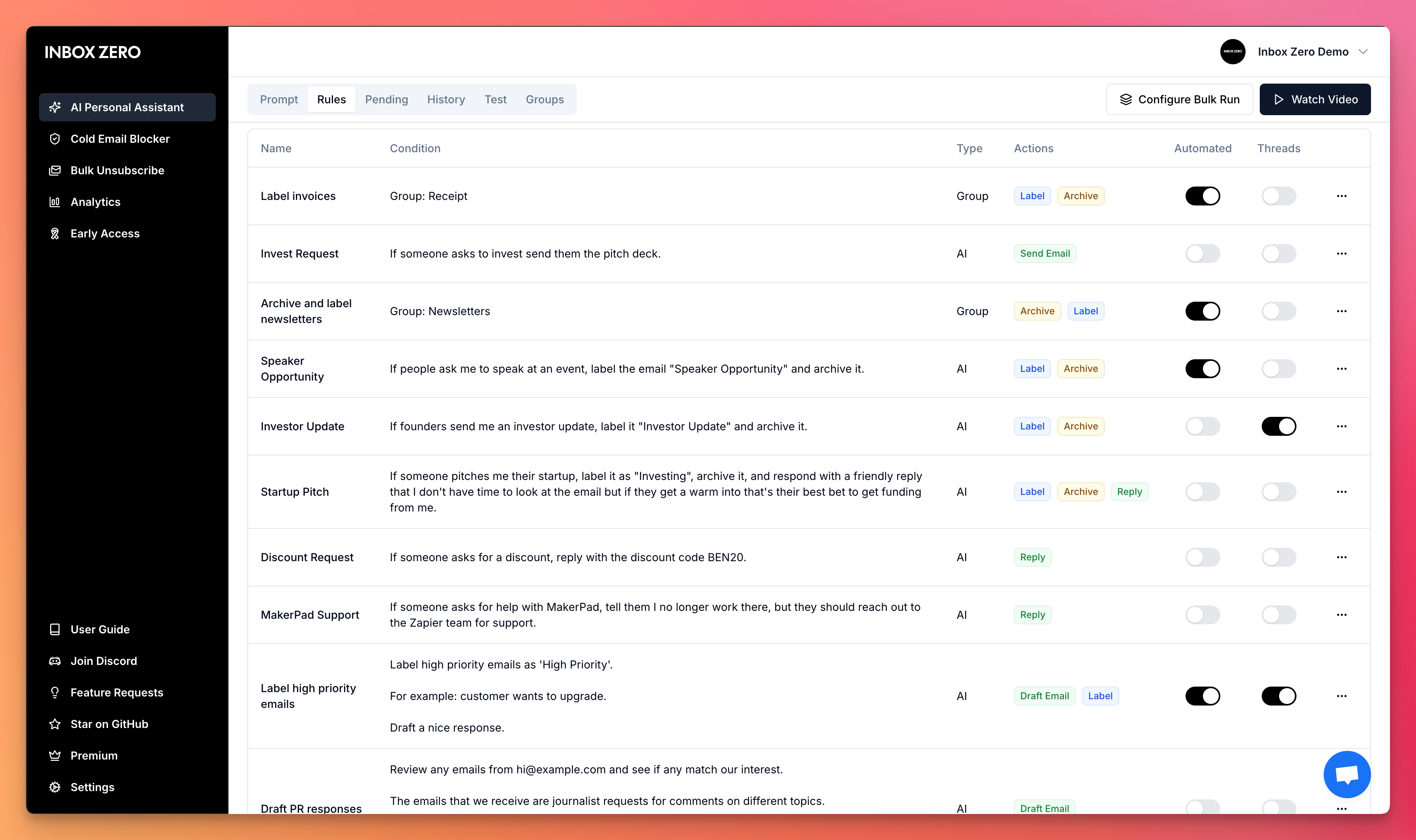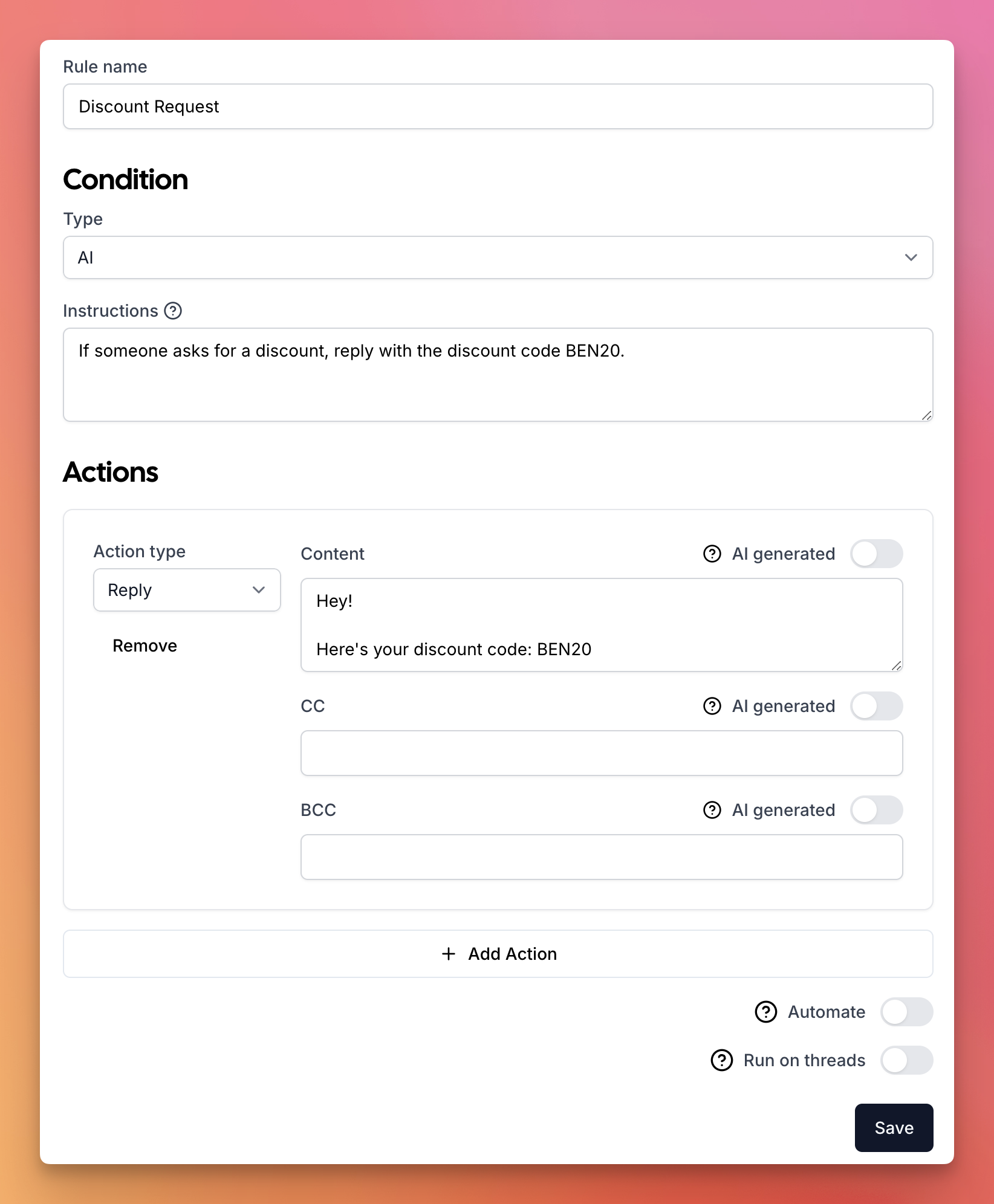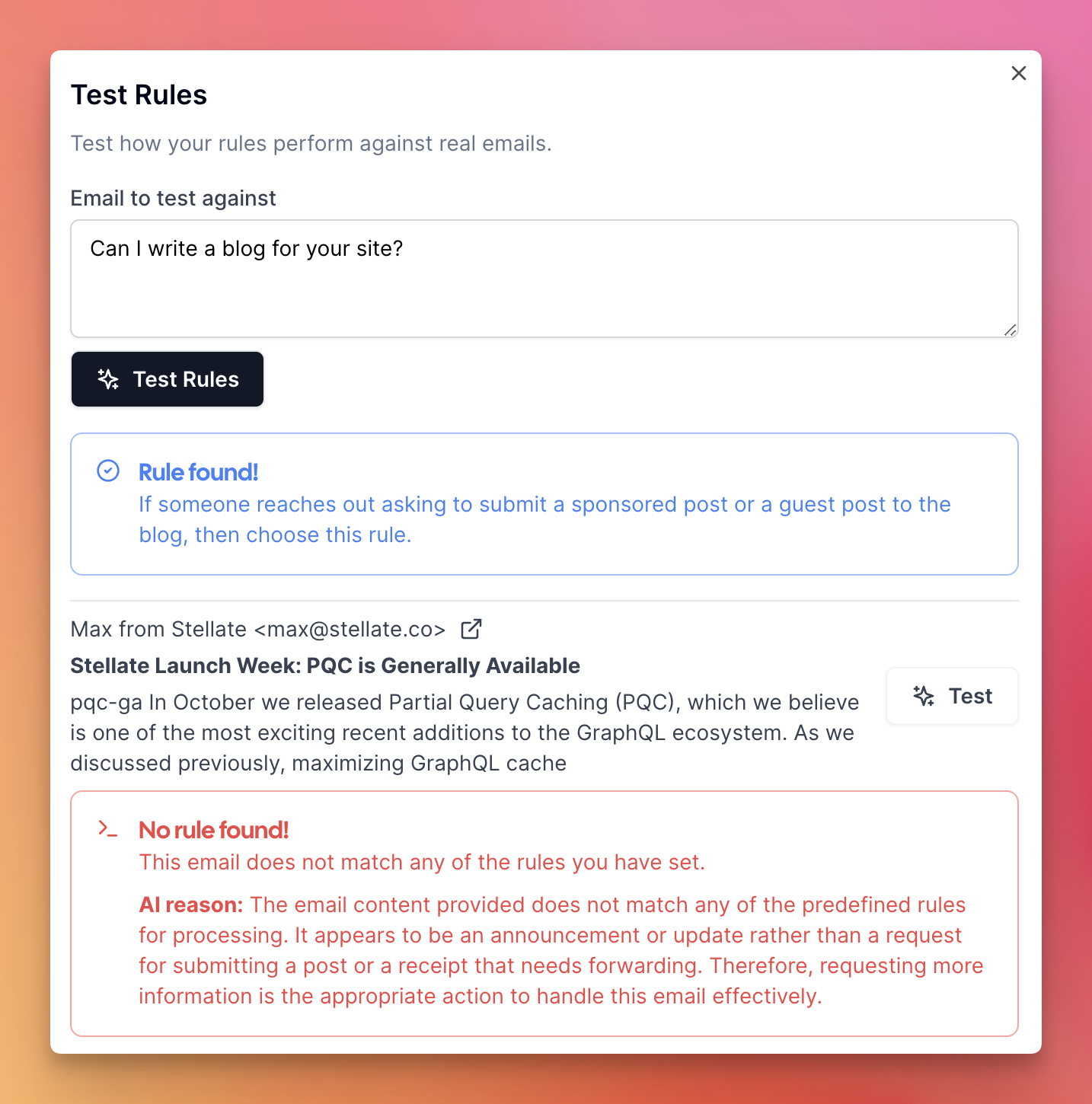Overview
The AI Personal Assistant is like having a human assistant manage your inbox, but at a fraction of the cost. It transforms how you handle email by saving you significant time each day - you can breeze through your inbox with pre-drafted responses ready to go, turning what used to take hours into minutes. At its core, it provides automatic organization by labeling and archiving emails based on your rules, keeping your inbox clean and organized. It also drafts replies to emails that need your attention. The AI learns your unique tone and writing style, so instead of starting from scratch with every email, you’ll find thoughtful responses that sound like you actually wrote them - maintaining your personal voice while saving you time. But the real power lies in its flexibility. Beyond these core features, you can create any custom rule to give your AI assistant a personalized role in managing your email. Want to automatically forward receipts to your accountant? Need to label all emails from team members or investors? Looking to set up complex workflows unique to your needs? The AI Personal Assistant adapts to whatever email management scenario you can imagine. We provide smart defaults to get you started immediately. Emails that need replies will automatically get draft responses, newsletters and marketing emails are properly categorized, and calendar-related emails are handled appropriately. These defaults work well for many users, but you’re free to customize everything to match your specific workflow.Getting Started
To set up AI Personal Assistant for your email, click on the
AI Personal Assistant tab in the left sidebar. Or visit this link.
Creating Rules
You can create rules in two ways:Natural Language Instructions
- Type instructions in plain English in the text area
- Use the example instructions on the right for inspiration
- Combine multiple instructions for comprehensive email management
- Click
Create Rulesand the AI will convert your instructions into rules
Manual Rule Creation
For more precise control, create rules manually by clicking theManually add rule button.
AI Chat Assistant
Need help with your rules? Use the AI chat assistant to:- Improve existing rules
- Add new rules based on your needs
- Get suggestions for better email management

Rules
On the Rules page, you can view and edit your rules. When you save your prompt the rules will be automatically created for you. But you can also decide to create rules manually.
How Rules Work
Rules are broken into two parts:- The condition to match against.
- The action to take when the AI finds a match.

Conditions
There are two main types of conditions:- AI: Write an instruction for the AI to match against the email.
- Static: Match against a static value:
From,To, orSubject.
Apply this rule if this email is asking me to set up a call.
When an email is received, the AI will use the prompt to determine if the email matches the condition.
Static Conditions
You can match against a static value: From, To, or Subject.
For example:
From: @email.com
This will match against any email that has @email.com in the From field.
The benefit of using static conditions is that they don’t require AI processing on every email, leading to greater efficiency and reliability.
Learned Patterns
Our AI automatically learns your behavior over time - no setup required! The system observes how you interact with emails and adapts accordingly. Viewing Learned Patterns- Click into any rule to see its learned patterns
- Usually, you don’t need to modify these
- Advanced users can manually adjust patterns if needed
Actions
Actions are what the AI does when a condition is met. You can add multiple actions to a single rule. Available actions:- Archive
- Label
- Reply
- Forward
- Send Email
- Draft Email
- Mark Spam
- Call Webhook
- Delayed Actions (archive or perform actions after a set time)
{{prompt}}.
Example:
{{...}} placeholders will remain exactly as written.
Apply to Threads
When an email arrives, the AI looks at all your rules to decide which one fits best. The “Apply to Threads” setting determines which rules the AI can choose from. If this is disabled on a rule, that rule is only available for standalone emails - the first email in a new conversation. When someone replies (creating what’s called a thread or email conversation), rules with this disabled won’t even be considered as options. For example, say you have 8 rules total. If 5 of them have “Apply to Threads” disabled, then when a reply comes in, the AI only chooses from the 3 rules that have it enabled. But for a brand new email starting a conversation, the AI can pick from all 8 rules. This improves efficiency because certain types of emails, like newsletters or receipts, are typically standalone and not part of a thread. By automatically excluding these rules from threaded conversations, the AI has a more focused set of options to evaluate, leading to faster and more accurate rule matching.Test Rules
You can test your rules by going to the Test tab. This will show you a list of emails. When you clickTest, the AI will run the rule against the email and show you which rule it matched against (if any).
You can also enter free-form text to test your rules.
To test all rules quickly, click Test All.

Fix Rules
If a rule isn’t behaving as expected (e.g., incorrectly marking emails as “to reply”):- Go to the History tab
- Search for the problematic email
- Click
Fix - Explain why this email shouldn’t match the rule
- The AI will adjust the rule accordingly
Email Digest
The digest feature helps you stay on top of important emails by sending you summaries at your preferred frequency. You can configure any rule to contribute to your daily or weekly digest, which collects and summarizes those emails for you. This is especially powerful for newsletters. If you receive 20 newsletters throughout the day, you can have them all included in a single digest that summarizes everything you received. Instead of reading each newsletter individually, you get one comprehensive summary of all the important updates.Delayed Actions
Delayed actions help you automatically clean up your inbox by archiving emails after a set period. This is perfect for low-priority emails that are only relevant for a short time - maybe a week or two - before they become noise in your inbox. For example, newsletters might be interesting for a week, but after that they’re just clutter. With delayed actions, you can have them automatically archive after 7 days. Your inbox stays clean without any manual effort, and those emails are still searchable if you need them later. Delayed actions aren’t limited to archiving. You can also use them for other automations like sending replies after a short delay - perhaps waiting 2 minutes before sending an automated response to make it feel more natural and less robotic.Call Webhook Action
This is a developer feature for integrating with other services. If you’re not a developer, you can skip this section!The
Call Webhook action allows developers to integrate email processing with other services and applications. When triggered, we will send the email data to your specified webhook endpoint with the following configuration:
- Method: POST
- Content-Type: application/json
- Headers: Includes
X-Webhook-Secretif configured in settings - Body: JSON object containing the email data and rule that triggered the webhook
X-Webhook-Secret header of every webhook request.
Use your own API key
Inbox Zero covers AI costs for you, but if you wish, you can use your own API key. Go to the settings page to set it up. You can use the following LLM providers:- Anthropic
- OpenAI
- Groq (Llama)
- OpenRouter (access to any LLM of your choice)
- Ollama (for self-hosted setups with 100% privacy)